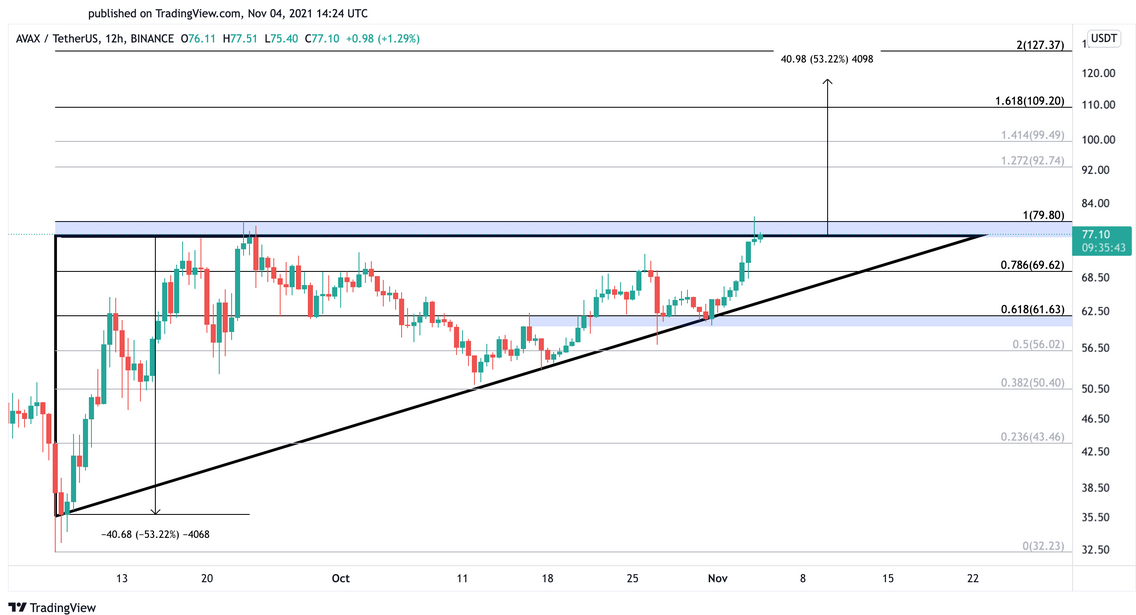Grayscale Says It’s Exploring Terra And Avalanche
Crypto Briefing | Nov 05, 2021 02:00AM ET
Grayscale has announced that it has added Terra and Avalanche to its assets under consideration.
Key Takeaways
- Grayscale is exploring adding Terra and Avalanche to its range of investment products.
- The LUNA and AVAX tokens could benefit from the news. Both assets are currently trading below crucial resistance.
- A spike in buying pressure behind LUNA and AVAX could help them rise to new all-time highs.
Institutional investors may soon be able to buy into Terra and Avalanche. Grayscale has announced that it has added LUNA and AVAX to its list of assets under consideration.
Grayscale Considers Adding Terra and Avalanche
Grayscale is weighing up adding the Layer 1 assets Terra and Avalanche to its range of investment products.
The world’s largest digital asset manager confirmed it was updating its assets under consideration Thursday. The firm added LUNA and AVAX to its , which already includes a wide variety of Layer 1 and DeFi tokens across different sectors, including Polygon, Polkadot, Solana, and others.
The investment giant further clarified that not all assets under consideration would be offered as investment products due to factors such as internal controls, custody arrangements, and regulations. Although Grayscale’s process of creating an investment product for Terra and Avalanche is complex and multifaceted, LUNA and AVAX could benefit from the announcement.
Both assets appear to be forming ascending triangles on their 12-hour charts, with the bullish continuation patterns suggesting that both cryptocurrencies are bound for significant gains. However, they must overcome crucial resistance first.
LUNA, AVAX Look Primed to Surge
Terra’s LUNA must print a 12-hour candlestick close above $49.54 to enter a new uptrend. Slicing through this hurdle could see the token surge by nearly 50% to hit a new all-time high of $75.
The bullish outlook derives from measuring the height of the triangle’s y-axis and adding that distance upward from the breakout point.

Likewise, Avalanche must break through $79.80 to achieve its upside potential. The ascending triangle formation projects that AVAX could surge by more than 50% after breaking its overhead resistance. In this eventuality, the token could make a new record high of $118.

It is worth noting that the bullish outlook for Terra and Avalanche is only likely to be validated upon the breach of their respective overhead supply barriers. Failing to do so could lead to significant losses. A failure to overcome their supply barriers could see LUNA drop toward $40, while AVAX may dip to $62.
Original Post
Trading in financial instruments and/or cryptocurrencies involves high risks including the risk of losing some, or all, of your investment amount, and may not be suitable for all investors. Prices of cryptocurrencies are extremely volatile and may be affected by external factors such as financial, regulatory or political events. Trading on margin increases the financial risks.
Before deciding to trade in financial instrument or cryptocurrencies you should be fully informed of the risks and costs associated with trading the financial markets, carefully consider your investment objectives, level of experience, and risk appetite, and seek professional advice where needed.
Fusion Media would like to remind you that the data contained in this website is not necessarily real-time nor accurate. The data and prices on the website are not necessarily provided by any market or exchange, but may be provided by market makers, and so prices may not be accurate and may differ from the actual price at any given market, meaning prices are indicative and not appropriate for trading purposes. Fusion Media and any provider of the data contained in this website will not accept liability for any loss or damage as a result of your trading, or your reliance on the information contained within this website.
It is prohibited to use, store, reproduce, display, modify, transmit or distribute the data contained in this website without the explicit prior written permission of Fusion Media and/or the data provider. All intellectual property rights are reserved by the providers and/or the exchange providing the data contained in this website.
Fusion Media may be compensated by the advertisers that appear on the website, based on your interaction with the advertisements or advertisers.